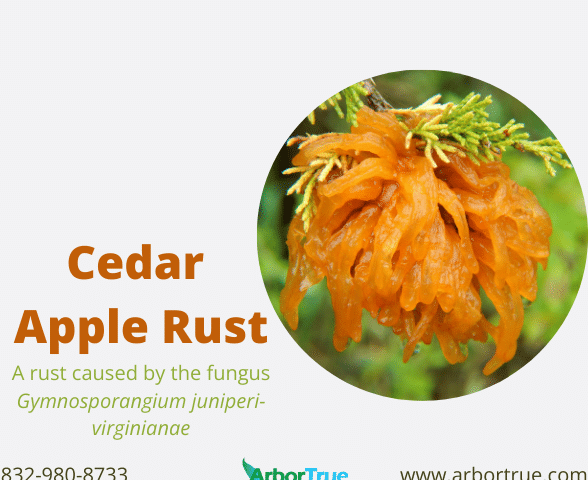
Mushroom Monday: Fringed Sawgill Mushroom (Lentinus crinitus)
August 5, 2024
A Brief Look At Land Snails
August 9, 2024
Cedar Apple Rust
In today’s TrueTreeTalk blog post we are going to look at the plant disease, Cedar Apple Rust.
Cedar apple rust is also called juniper-apple rust. It is caused by the fungus Gymnosporangium juniperi-virginianae. The disease can be found in the eastern part of North America, in rural places in the borders between farms and forests, among other locations. It can be found growing in places that have been disturbed, as well as places that are open. Cedar apple rust, and other rusts, are called rusts because of the red or orange color that they have at some point during their life cycles.
The Hosts
The fungus that causes cedar apple rust needs two different hosts that are one mile apart or less for it to complete its life cycle. This is similar to other rusts that also require two hosts.
One of the hosts that it needs is a species of juniper (e.g. eastern redcedar (Juniperus virginiana)) (more generally a plant of the family Cupressaceae). We’ve looked at a type of juniper before. It was Ashe juniper, a common tree in Austin, Texas.
The other host it needs is some type of crabapple, apple, quince, or hawthorn (more generally a plant of the family Rosaceae). A type of apple tree we’ve looked at before was the Anna apple.
The form of the fungus will be different depending on the host.
The Lifecycle
The lifecycle of cedar apple rust is complex and consists of four different spores.
The first kind of spore is called teliospores. They are produced on orange colored, jelly-like horns that come out of balls that grow on junipers. The growths can be quite noticeable and it can take two years before the horns are produced on them. The balls can dry and rehydrate a number of times.
Teliospores become basidia after they germinate on junipers. The basidia release the second kind of spore, basidiospores. These are produced on junipers, travel in the air, and germinate on the leaves or fruit of hawthorns, apples, and related plants, causing yellowish-red spots on leaves and fruit. Wet conditions can help with germination. As the spots mature, they form tubes on the underside of the leaves. Spores are released from these tubes. Although different kinds of rust produce different types of spores, they always produce basidiospores.
After the basidiospores germinate, they form spermogonia. The spermogonia then produces a spore called spermatia. Spermatia are carried by insects (who like the liquid that contains them). The spermatia are carried by insects to other apple, hawthorn, or similar trees, and then produce aecia.
Aecia produces spores called aeciospores. The aeciospores are blown by the wind and land on redcedars and junipers. At this point, the process starts over.
The fungus that causes cedar apple rust can be found during the yearly growth period of susceptible plants and isn’t isolated to one time period. Signs of it can be more prevalent after it has rained a number of times.
Preventative Measures
Rusts can affect a number of different plants including crops. They can reduce fruit yields, cause leaf damage, cause blemishes on fruits, and can cause redcedar to die. The damage caused by rust causing fungi in some cases might be minor and might not necessitate intervention.
One preventative measure is not planting the two kinds of hosts (junipers and eastern red cedar as the primary host, and hawthorns, apples, and related plants as the secondary host) near to each other. The required distance apart can vary but might need to be more than one thousand feet.
Another preventative measure can be planting plant varieties that are resistant to different rusts. In some cases though, a plant can be resistant to one type of rust but will be prone to another.
Pruning infected branches from junipers and apples (and related trees) before their spores are released might also help slow the spread of the disease.
Fungicides generally aren’t seen as a solution. Trees that have infections can generally tolerate them without fungicide application. Also, fungicides for garden use aren’t an option for plants with fruits that people will eat. Additionally, fungicides can affect wildlife that eat fruit and visit flowers of susceptible plants. There are some fungicide options available though for ornamental plants.
If you liked learning about cedar apple rust check out our other posts on our TrueTreeTalk blog. Follow us on Facebook to keep up with these and other posts.
* * *
ArborTrue is a science-based tree-service company in the greater Houston area. We provide a range of services including tree trimming, tree pruning, tree removal, tree planting, arborist consultations, and more. Call us today at 832-980-8733 or reach out to us online to schedule an appointment.




